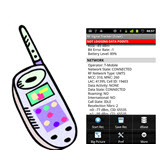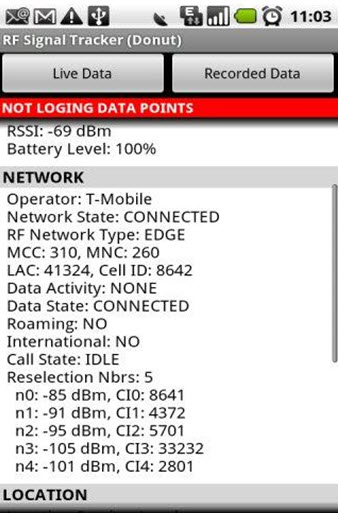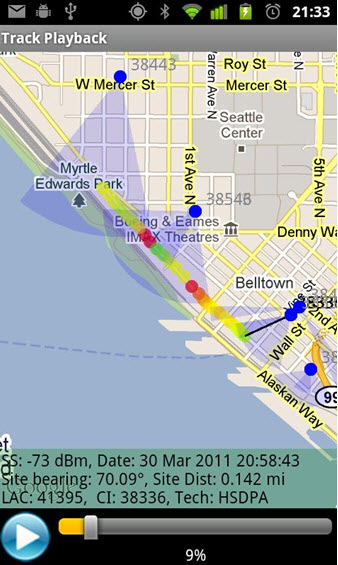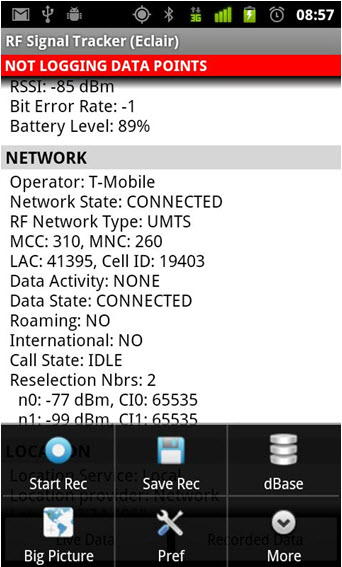Introduction
The evaluation of the network through the phone’s screen is possible using the feature known as a Field Test.

However, there is not much documentation available about this feature, so let’s talk a bit about it today.
The goal is to allow any IT or Telecom professional to check network engineering information.

What is Field Test?
Field Test is also known as Test Mode, Engineering Mode, Net Monitor or some other similar variation.
The mobile device is a receiver / transmitter that ‘talk’ with the Radio Base Stations (BTS’s) through Messaging. Receives and decodes messages such as received signal level, channel control, neighboring cells, etc…
All phones must necessarily ‘know’ that information to access the system for example, make a call or do a handover.
The Field Test is the feature that displays these data on the mobile screen.

And is this feature present in all brands and models of phones?
All this information is ‘useless’ to the vast majority of users. Therefore, this functionality - generally - is not ‘open’.
However, the information is very important for professionals who know what they mean.
For example, you see the Field Test: RxPwr -90 dBm. What does this mean?

A professional will know that this means that the signal level is -90 dBm; Still other parameters should be examined, neighbors conditions, Link Budget (technology in use - GSM, CDMA, UMTS, LTE …), outdoor or indoor losses, among others.
Knowing the cell information server (control channels, voice, etc. …), and information from neighbors such as the professional can decide for example whether it is necessary to make some kind of adjustment in the system.
The possibilities are endless. Again, however, useful only to professionals.
And how to access the Field Test on my phone?
That depends. Understand the Field Test software or as a basic application that shows data on the mobile screen.
Almost all CDMA phones come with this ‘software’ Field Test installed. Just know the sequence of keys that must be typed and ready. (On some models you need to access it’s programming mode and enable this option.)
GSM phones already in general does not come with the Field Test ‘installed’. To access the Field Test, you must first install a software on the device.

Is that even legal?
This is where the questions begin, and if it is allowed or not. In general, if your mobile is under warranty, the answer is no - you will not want to lose your warranty, will you? Besides, there is a doubt about installation of vendors proprietary software - some companies develop software for their specific use - and it’s not available to the general public. What happens is that some of these softwares leak.

Since the goal here is to simply inform, we’ll give an explanation for everything that is involved in these processes. So you can draw your own conclusions about what can be done.
Change the Cell Phone Software
Change the software installed - flashing - is a user’s own choice, at your own risk. This operation, as well as the unlocking, is done using the phone cable by connecting it to a computer with specific software installed.
Usually the changes are made by technical assistance, but can be made by mobile hackers, especially in cases of unlocking devices, for example to allow another carrier chip to be used, set bluetooth open, put wallpaper, etc… Some carriers provides their phones fully unlocked, others prefer to lock up. Therefore, one must examine each case depending on the rules of the country, the carriers rules for unlock the equipment , etc…
Speaking more technically, the cell has a special memory called EEPROM. This memory is where the information of mobile is, and it’s called by the same when necessary. That is, the same as the motherboard of the computers has a memory where they store their operating system, this memory stores the operating system that manages the entire cell phone. As most of them are read / write access, you can erase the operating system and switch to another / better - update. Or simply add what is needed.
In summary, the handset comes with some functions / features ‘locked’, but if it is ‘flashed’, these functions can be unlocked.
However, as mentioned, some of these operations are not legal. For example, can be unlocked sounds, space (KB), games. But if your carrier does not permit this, we had an illegal procedure.
Remember that there are other dangers: a badly flashed phone may stop working, or at least have to be taken to the Technical Assistance to make a repair - which will generate costs!
There are numerous websites that assist in this task, all warning about the possible risks of damage that may occur. This is not the focus of our site, so is up to you look for more on this subject, for example searching in Google.
Again, we remember: the changes are not so simple, and should be done at your own risk - including legal.
Of course there are the installation of legal software supplied by vendors to operators, especially in cases of testing for approval of new devices.

And also the softwares provided by the vendors themselves, so-called Software Updates, eg for the user to solve any problem with the device (bugs). In such cases, it is always worth following the steps below.
-
Make a complete backup of the device;
-
Being with the device’s battery fully charged (essential)
-
Choose the appropriate update for your device,
-
And be patient: it takes a long time for updates to be applied.
Android
But now a new scene is emerging, creating a new way of seeing the applications of cell phones - including the Field Test.
Much of this revolution is due to the new operating system for mobile phones from Google: Android.
That’s because Android allows anyone to develop applications that use the available information of the mobile. The service includes an SDK - Software Development Kit, external libraries, applications, hosting services, API’s.
Therefore, to we have a Field Test application for a device running Android, we just need to develop an application that manipulates the information it already has - as if they were variables in the code programming - and present them in an interface on the device screen.
When someone develops a new application, it can be submitted to Andoid Market, became available for everyone who uses the Androidd install it. There are free and paid applications:
https://market.android.com/apps/TOOLS
Example of Field Test Like Application with Android
There are many applications already built with the concept of the old Field Test. Certainly, many others will also be created, and increasingly we will have real 'Drive Test Software".
Just to illustrate, let’s see one of these programs, the RF Signal Tracker .
And the best way to do so is lloking at some screenshots with the program running.
Below, we see a standard screen, much like the Field Test we’re used to in old appliances.
But now, get better. As the - almost all- device has GPS inside, you can make a real online drive test, including here show the best server! See another screen RF Signal Tracker.
And the options do not stop there. You have options to save your data and then export to a more complete analysis on your computer.
If you want more information about this program, you can access the site:
Conclusion
And then: are you still satisfied with the old screen of Field Test?
Well, it’s not hard to see that it’s future is in their final days, isn’t it?


